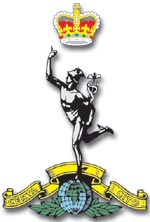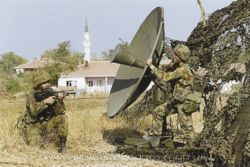Royal Corps Of Signals
 From Conservapedia
From Conservapedia The Royal Corps of Signals is a combat support "arm" of the British Army, responsible for the installation, maintenance and operation of telecommunications equipment and information systems.
History[edit]
Morse Code and electric telegraph were used for the first time in the Crimean War (1835-1837) and, following the Abyssinian War in 1867 a Signal Wing was formed by the Royal Engineers at Chatham, Kent. In 1884, the Telegraph Battalion Royal Engineers was formed and served in the Nile Campaign and the Ashanti Campaign, during which men of the Telegraph Battalion cut a path for an overhead line from the Cape coast to Prahsu, 72 miles through jungle. The feat was such that King Prempeh offered the surrender of his Army, awed by their determination. King Prempeh's throne is now displayed in the Royal Signals Museum at Blandford, Dorset.
The Telegraph Battalion continued to operate communications during the Boer War until the Royal Engineer Signals Service was formed in 1908, which provided communications throughout World War One. Although planned since before the end of the war, a dedicated Signal Corps was not created until 1920. A Royal Warrant was signed by the Secretary of State for War, Winston Churchill, who gave the Sovereign's approval for the formation of a Corps of Signals on June 28, 1920. Six weeks later, the King bestowed the title Royal Corps of Signals.
Units[edit]
Brigades[edit]
- 1 Signal Brigade (Germany) (7 and 16 Signal Regiments plus Allied Rapid Reaction Corps Support Battalion)
- 2 (National Communications) Signal Brigade (10, 31, 32, 36, 37, 38, 40 and 71 Signal Regiments, plus 1, 2 and 81 Signal Squadrons and LIAG)
- 11 Signal Brigade (2, 14, 30, 33, 34 and 35 Signal Regiments)
Regular Army[edit]
- 2 Signal Regiment
- 214 Signal Squadron
- 219 Signal Squadron
- 246 Gurkha Signal Squadron
- 7 (Allied Rapid Reaction Corps) Signal Regiment
- Headquarters Squadron
- 229 Signal Squadron
- 231 Signal Squadron
- 232 Signal Squadron
- 10 Signal Regiment
- 238 (London) Signal Squadron
- 241 Signal Squadron
- 243 Signal Squadron
- 251 Signal Squadron
- ECM Signal Squadron (Northern Ireland)
- 14 Signal Regiment (Electronic Warfare)
- Headquarters Squadron
- 224 Signal Squadron (Electronic Warfare)
- 226 Signal Squadron (Electronic Warfare)
- 237 Signal Squadron (Electronic Warfare)
- 245 Signal Squadron (Electronic Warfare)
- 15 Signal Regiment
- Headquarters Squadron
- 233 Signal Squadron
- 225 Signal Squadron
- 16 Signal Regiment
- Headquarters Squadron
- 230 Signal Squadron
- 255 Signal Squadron
- 252 Signal Squadron
- 18(UKSF) Signal Regiment
- 21 Signal Regiment (Air Support)
- HQ Squadron
- 220 Signal Squadron
- 244 Signal Squadron
- 248 Gurkha Signal Squadron
- 22 Signal Regiment
- HQ Squadron
- 217 Signal Squadron
- 222 Signal Squadron
- 248 Gurkha Signal Squadron (From 21 Signal Regiment (Air Support))
- 30 Signal Regiment
- Support Squadron
- 250 Gurkha Signal Squadron
- 256 Signal Squadron
- 258 Signal Squadron
- British 1st Armoured Division Headquarters and Signal Regiment
- Headquarters Squadron
- 201 Signal Squadron(Wheeled Sqn)
- 211 Signal Squadron (Armoured Sqn)
- 212 Signal Squadron (Armoured Sqn)
- 3 (UK) Division Headquarters and Signal Regiment
- Headquarters (Somme) Squadron
- 202 Signal Squadron
- 206 Signal Squadron
- 222 Signal Squadron
- Royal School of Signals
- 11 Signal Regiment
- British 20th Armoured Brigade 20th Armoured Brigade Headquarters and Signal Squadron (200)
- British 4th Armoured Brigade 4th Armoured Brigade Headquarters and Signal Squadron (204)
- British 7th Armoured Brigade 7th Armoured Brigade Headquarters and Signal Squadron (207)
- British 1st Infantry Brigade (Guards) 1 Mechanised Brigade Headquarters and Signal Squadron (205)
- 19th Infantry Brigade|Mechanized Brigade Headquarters and Signal Squadron (209)
- 39 Infantry Brigade Headquarters and Signal Squadron (213)
- 16 (Air Assault) Brigade Headquarters and Signal Squadron (216)
- 8 Infantry Brigade Headquarters and Signal Squadron (218)
- 12 Mechanised Brigade Headquarters and Signal Squadron (228)
- 101 Logistic Brigade Headquarters and Signal Squadron (261)
- 102 Logistic Brigade Headquarters and Signal Squadron (262)
- 264 (Special Air Service) Signal Squadron
- 628 Signal Troop (UK DCM(A)) 1 NATO Signal Battalion
- Defence Communication Services Agency (DCSA)
- Joint Service Signal Unit (Cyprus) (British Forces Cyprus)
- Cyprus Communications Unit (British Forces Cyprus)
- Joint Communications Unit (Falkland Islands)
- Band of the Royal Corps of Signals
Territorial Army[edit]
- 31 (City of London) Signal Regiment (Volunteers)
- Headquarters Squadron/83 (London) Support Squadron (Volunteers) Southfields
- 5 (Queen's Own Oxfordshire Hussars) Signal Squadron (Volunteers) Banbury
- 41 (Princess Louise's Kensington) Signal Squadron (Volunteers) Coulsdon
- 56 Signal Squadron (Volunteers) Eastbourne
- 32 (Scottish) Signal Regiment (Volunteers)
- Headquarters Squadron Glasgow
- 51 (Highland) Signal Squadron (Volunteers) Aberdeen
- 52 (Lowland) Signal Squadron (Volunteers) East Kilbride
- 61 (City of Edinburgh) Signal Squadron (Volunteers) Edinburgh
- 33 (Lancashire and Cheshire) Signal Regiment (Volunteers)
- 42 (City of Manchester) Signal Squadron (Volunteers) Manchester
- 55 (Merseyside) Headquarters Squadron (Volunteers) Huyton
- 59 (City of Liverpool) Signal Squadron (Volunteers) Liverpool
- 80 (Cheshire Yeomanry) (Earl of Chester's) Signal Squadron (Volunteers) Runcorn
- 34 (Northern) Signal Regiment (Volunteers)
- 35 (South Midlands) Signal Regiment (Volunteers)
- Headquarters Squadron Coventry
- 48 (City of Birmingham) Signal Squadron (Volunteers) Birmingham
- 58 (Staffordshire) Signal Squadron (Volunteers) Newcastle under Lyme
- 89 (Warwickshire) Signal Squadron (Volunteers) Rugby
- 95 (Shropshire Yeomanry) Signal Squadron (Volunteers) Shrewsbury
- 36 (Eastern) Signal Regiment (Volunteers)
- 37 (Wessex and Welsh) Signal Regiment (Volunteers)
- Headquarters Squadron Redditch
- 53 (Welsh) Signal Squadron (Volunteers) Cardiff/Brecon
- 67 (Queen's Own Warwickshire and Worcestershire Yeomanry) Signal Squadron (Volunteers) Stratford on Avon/Stourbridge
- 96 Signal Squadron (Volunteers) Coventry/Harborne
- 38 Signal Regiment (Volunteers)
- Headquarters Squadron Sheffield
- 46 (City of Derby) Signal Squadron (Volunteers) Derby
- 64 (City of Sheffield) Signal Squadron (Volunteers) Sheffield/Nottingham
- 93 (East Lancashire) Signal Squadron (Volunteers) Blackburn/Manchester
- 39 (Skinners) Signal Regiment (Volunteers)
- Headquarters Squadron (North Somerset Yeomanry) Bristol
- 57 (City and County of Bristol) Signal Squadron (Volunteers) Bristol
- 94 (Berkshire Yeomanry) Signal Squadron (Volunteers) Windsor/Reading/Chertsey
- 40 (Ulster) Signal Regiment (Volunteers)
- Headquarters Squadron [Belfast]
- 66 (City of Belfast) Signal Squadron (Volunteers) Belfast
- 69 (North Irish Horse) Signal Squadron (Volunteers) Limavady
- 85 (Ulster and Antrim Artillery) Signal Squadron (Volunteers) Bangor
- 71 (Yeomanry) Signal Regiment (Volunteers)
- 47 (Middlesex Yeomary) Signal Squadron (Volunteers) Uxbridge
- 68 (Inns of Court and City Yeomanry) Signal Squadron (Volunteers) London/Whipps Cross
- 70 (Essex Yeomanry) Signal Squadron (Volunteers) Chelmsford/Harlow
- 265 (Kent and County of London Yeomanry) Support Squadron (Volunteers)Bexleyheath
- 1 (Royal Buckinghamshire Yeomanry) Signal Squadron (Special Communications) (Volunteers) Bletchley
- 2 (City of Dundee) Signal Squadron (Volunteers) Dundee
- 63 (SAS) Signal Squadron (Volunteers) Thorney Island/Southampton/Portsmouth/Bournemouth/Chichester/London
- 81 Signal Squadron (Volunteers) Corsham
- 97 (BRITFOR) Signal Squadron (Volunteers)
- 98 (Balkans) Signal Squadron (Volunteers)
- Land Information Assurance Group (LIAG) (Volunteers) Corsham
External links[edit]
- The Wire Official Regimental magazine (pdf June 2007 edition)
Categories: [Military]
↧ Download as ZWI file | Last modified: 03/04/2023 06:22:28 | 5 views
☰ Source: https://www.conservapedia.com/Royal_Corps_of_Signals | License: CC BY-SA 3.0
 ZWI signed:
ZWI signed:

 KSF
KSF